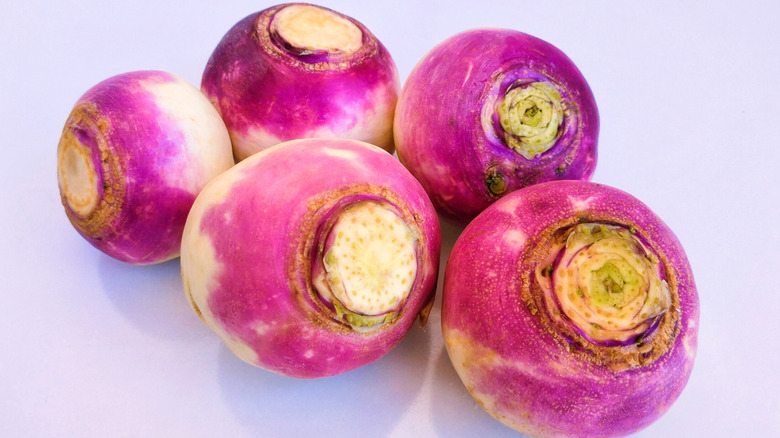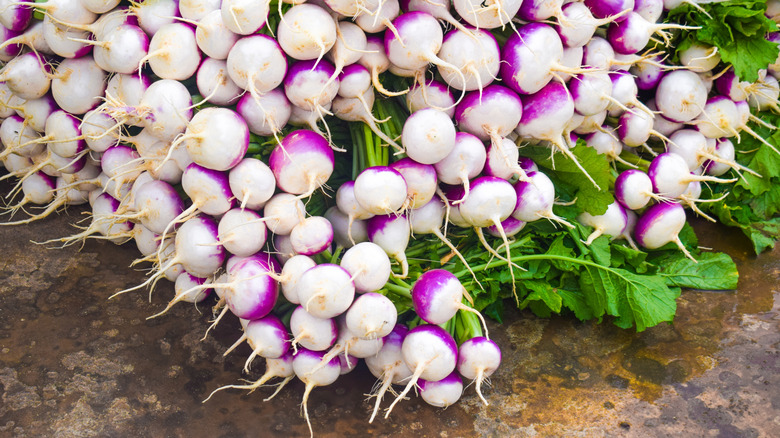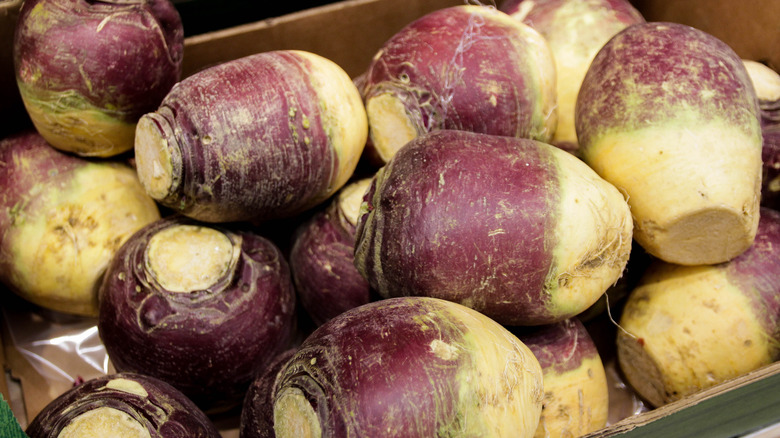Turnips Vs Rutabagas: What's The Difference Between The Two?
The next time you peruse the produce section at the supermarket, skip the usual carrots and lettuce for a vegetable you're not used to eating. Exploring what options are out there and learning new ways to cook them is the fastest way to expand your gastronomic horizons. You could even stumble upon your next favorite food. If you're not sure where to start, try picking out two vegetables that seem similar at first glance, like turnip and rutabaga.
Turnips and rutabagas are both bulbous, round, purplish vegetables with white ends and long green stalks. They're both root vegetables, related to cabbage, and are a great way to fill out a number of dishes. However, while these two veggies may be part of the same family, they have many flavor and consistency differences that marks each as a distinct vegetable. Not to mention, turnips are much more common in the United States, while rutabagas are often overlooked.
Turnips are smaller and spicier
Despite some of their visual similarities, it's very easy to distinguish turnips from rutabagas if you take a closer look. Turnips are much smaller than rutabagas and are actually considered past their prime once they reach a diameter of more than about three inches. The part of the turnip bulb closest to the stalk is usually purple, with a white underside brighter than that of a rutabaga. Additionally, turnip stalks are a lighter, more vibrant green than rutabaga stalks. Turnips are also often mistaken for kohlrabi, but there are differences between those vegetables as well.
In terms of taste, turnips mostly have the neutral, fresh, slightly bitter taste of cabbage, with a hint of spiciness similar to a radish. A good quality turnip should be completely edible, which means you don't have to peel it before digging in — just be sure to give it a good rinse first to remove any dirt. Both turnips and rutabagas have a similar crisp, crunchy texture.
Turnips were initially grown millennia ago by the ancient Greeks and Romans. Overtime, the vegetable's popularity grew throughout Europe and was eventually brought to the new world by colonists. While the root was good enough to be featured at a wealthy Southern table, the top greens were often discarded and considered trash. Due to the consequences of slavery, those inexpensive and nutritious turnip greens became an important component of Southern Black American cuisine.
Rutabagas are larger and more sweet
Rutabagas hail from central Europe, and are also known as "Swedes" and "Canadian turnips." Believe it or not, the reason rutabagas and turnips seem so similar is because rutabagas are actually a hybrid veggie made from turnips and cabbage. This means that when it comes to taste and texture, these culinary cousins are very alike; the only real difference is that rutabaga's flavor is a bit sweeter and more intense. Most of the differences between the vegetables is on the surface level. Rutabagas are bigger, with a yellowish underside rather than a white one.
There are also many similarities in how these two veggies are both enjoyed, since they can be prepared like most other starchy root vegetables. You can eat them raw, turn them into a mash, cut them into cubes and roast them, or add them to a cozy soup. You can also eat the leafy parts of the stalks of each vegetable. Both varieties can be cooked like you would mustard or collard greens, and both have a cabbage flavor (rutabaga greens are more mild than turnip greens).


